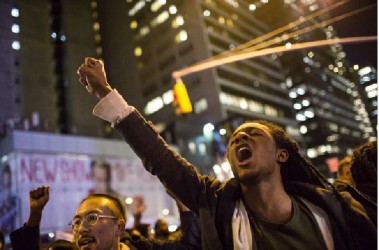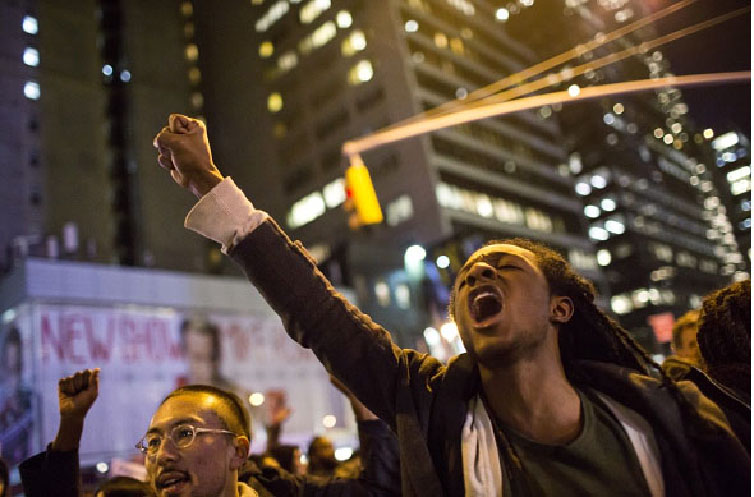NEW YORK, (Reuters) – Thousands of protesters were expected to take to the streets of New York yesterday in a third day of demonstrations against police violence, even as prosecutors said they would consider charges against an officer for the fatal shooting of an unarmed black man in November.
The shooting of Akai Gurley, 28, in a dimly lit stairwell in Brooklyn added to a string of police actions involving unarmed black men that have inflamed racial tensions throughout the United States.

Since Wednesday, when a New York grand jury cleared white police officer Daniel Pantaleo in the July chokehold death of 43-year-old father-of-six Eric Garner, the city has seen two nights of angry but largely peaceful demonstrations.
The decision was announced nine days after another grand jury declined to indict a white policeman for the killing in August of an unarmed black teenager in Ferguson, Missouri, spurring rioting in the St. Louis suburb.
Then on Thursday in Phoenix, Arizona, another unarmed black man was shot dead by a white police officer during a scuffle, leading to protests there.
“The government has created a monster and the monster is now loose,” said Soraya Soi Free, 45, a nurse from the Bronx who has been protesting in New York.
A wake for Gurley was scheduled for last night, with his funeral to follow today.
Civil rights leader Reverend Al Sharpton had initially planned to speak but said late Friday he would pay his respects without making an address.
Brooklyn District Attorney Kenneth Thompson said on Friday he will convene a grand jury to consider charges against the officer who shot Gurley. Police officials have said the officer, Peter Liang, may have accidentally discharged his gun.
At a press conference with Gurley’s relatives on Friday, Kevin Powell, the president of the advocacy group BK Nation, called the shooting part of a “series of modern-day lynchings.”
Gurley’s mother, Sylvia Palmer, tearfully demanded justice for her son.
In Cleveland on Friday, the family of a 12-year-old boy fatally shot by police filed a lawsuit against the city, a day after the federal government found the police department systematically uses excessive force.
SOFT APPROACH
New York police have taken a soft approach during this week’s protests, generally allowing marchers to proceed unhindered.
Tensions briefly erupted late Thursday in Times Square as a multiracial crowd of about 3,000 protesters blocked a major intersection, chanting at police, “Who do you protect?”
Hundreds of officers responded, shoving protesters onto sidewalks. A police spokesman said Friday more than 200 had been arrested.
While most businesses in midtown Manhattan have remained open throughout, some stores have curtailed their hours in response to the unrest.
Representatives of Best Buy Co Inc and Target Corp said the companies had temporarily closed stores early as a precaution.
Ralph Martel, vice president of New York-based Cambridge Security Services, which provides retail security, said several stores have beefed up patrols and added plain clothed guards.
“We have seen a 30 pct increase in need for personnel,” he said.
CHOKEHOLDS
Unlike the Aug. 9 shooting of 18-year-old Michael Brown in Missouri, Garner’s encounter was captured on video. It showed Pantaleo wrapping his arm around Garner’s throat and wrestling him to the sidewalk as three other officers helped subdue him.
Garner, who was asthmatic, repeatedly gasped, “I can’t breathe” – a phrase protesters have taken up as a rallying cry.
He was being arrested on suspicion of selling cigarettes illegally.
Pantaleo could still face disciplinary action from an internal police investigation, his lawyer said. Chokeholds are banned by police department regulations.
Pantaleo told the grand jury he used a proper takedown technique and never put pressure on Garner’s neck, according to his lawyer, Stuart London. The city’s medical examiner has said Garner’s death was caused by compressing his neck and chest, with his asthma and obesity contributing.
U.S. Attorney General Eric Holder has said the Justice Department will pursue civil rights investigations into both the Missouri shooting and the New York case, though legal experts have said federal charges for the two officers are unlikely.
Separately yesterday, New York City Mayor Bill de Blasio said police misconduct complaints from July to November had dropped more than a quarter since the same period last year.
De Blasio, who came to office vowing to repair the trust between police and minority communities, said the decline reflected reform efforts, including lessening the use of police tactic known as “stop-and-frisk” which critics say unfairly targets minorities.
A handful of officers were expected to begin wearing body cameras as early yesterday, part of a pilot program ordered by a federal judge last year as part of stop-and-frisk changes.

